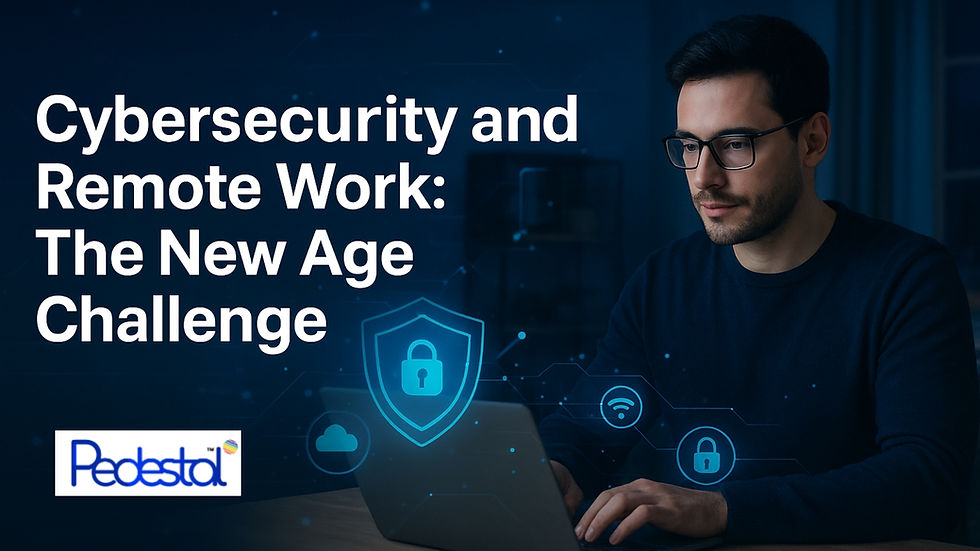Cybersecurity and Remote Work: The New Age Challenge
- pedestaltechno6
- Aug 20
- 4 min read

Remote work has reshaped how companies operate, creating a blend of flexibility and efficiency that was once considered impossible. Employees now collaborate across continents, businesses save operational costs, and digital platforms have become the backbone of communication. But alongside these advantages comes an urgent concern—cybersecurity. The risks that come with remote work environments are unlike anything traditional office-based systems faced. This is where structured learning, such as a cyber security course in Jaipur, becomes valuable for aspiring professionals who want to address these new-age threats.
The Shift to Remote Work and Rising Cyber Risks
The COVID-19 pandemic forced a rapid transition to work-from-home setups, and many companies have since adopted hybrid or fully remote models. While the benefits are undeniable—flexibility, reduced commuting, global talent pools—the tradeoff is a greater exposure to cyber risks. Employees often access sensitive company data from personal devices, use home Wi-Fi networks that lack enterprise-level security, and install tools that aren’t vetted by IT departments.
This digital sprawl has widened the attack surface for hackers. Unlike the secure office networks monitored by corporate IT teams, remote setups often rely on individuals’ personal responsibility. Cybercriminals exploit these vulnerabilities, launching attacks that specifically target remote workers who may lack awareness or protection.
Why Remote Work Attracts Cyber Threats
Remote work brings convenience, but it also lowers the barriers for attackers. Some of the most common reasons include:
Unsecured Wi-Fi connections: Home networks rarely offer enterprise-grade security, making them easy targets.
Personal device usage: Many employees use personal laptops or smartphones for office work, often without updated security patches.
Reduced monitoring: IT teams cannot oversee remote environments as closely as office systems, leading to blind spots.
Human error: With less direct supervision, employees are more prone to clicking phishing links or downloading suspicious attachments.
In essence, the convenience of remote work has made businesses more vulnerable, compelling organizations to rethink how they protect data and operations.
Common Cyber Threats in Remote Work
Phishing AttacksCybercriminals exploit human psychology, sending deceptive emails that mimic trusted contacts. Remote workers are prime targets, as they rely heavily on digital communication.
RansomwareHackers infiltrate systems and lock critical data, demanding ransom to restore access. Remote work has seen a surge in such incidents, often triggered by compromised home devices.
Weak Passwords and Credential TheftEmployees juggling multiple accounts often reuse or create weak passwords, making them easy to crack.
Shadow ITWorkers frequently download unauthorized apps to simplify tasks. While convenient, these tools may lack security safeguards.
Cloud Security IssuesMisconfigurations in cloud platforms—widely used in remote collaboration—can expose sensitive business data to the public internet.
Strategies for Organizations to Enhance Security
Businesses cannot rely on outdated methods to secure a remote workforce. Instead, they need a layered security approach:
VPNs and Multi-Factor Authentication (MFA): Secure remote access and prevent unauthorized logins.
Endpoint Security: Protect laptops, phones, and tablets with advanced antivirus and monitoring tools.
Regular Patching: Ensure software is consistently updated to remove vulnerabilities.
Clear Security Policies: Define what employees can and cannot do on personal devices.
Continuous Training: Educate staff about phishing, social engineering, and safe practices.
Corporate leaders increasingly invest in corporate training sessions to make cybersecurity knowledge accessible across all departments, ensuring employees are not the weakest link.
Skills Needed for Cybersecurity Professionals in Remote Work Era
The remote work era has changed the skill demands for cybersecurity specialists. Companies now seek professionals who can:
Analyze Risks: Identify vulnerabilities in home setups and cloud-based workflows.
Master Cloud Security: Understand AWS, Azure, and Google Cloud to secure remote collaboration.
Respond Quickly: Incident response skills are critical in containing breaches.
Communicate Effectively: Security teams must explain risks clearly to non-technical staff.
For students and professionals, upskilling in these areas has become essential. Practical exposure, often gained through a virtual internship, adds hands-on knowledge that employers value highly.
Cybersecurity Learning Path for Remote Work Challenges
The rise of remote work has created a skills gap in the cybersecurity sector. Companies are desperate for professionals who can safeguard distributed workforces, and this demand is driving a surge in specialized training programs.
A cyber security course online allows learners to acquire skills from home, reflecting the very environment they will one day secure.
Programs offering cyber security certifications online validate expertise and enhance credibility when applying for jobs.
Real-world projects through cybersecurity internships help bridge the gap between theoretical knowledge and practical scenarios.
By combining theoretical study with practical experience, aspiring professionals can prepare themselves for the evolving threat landscape.
The Future of Cybersecurity in Remote Work
Remote work is not a passing trend—it is becoming a permanent part of global business operations. With that, cybersecurity strategies must evolve. We are likely to see:
Greater adoption of Zero Trust frameworks, where no user or device is trusted by default.
Increased automation and AI-based monitoring to detect unusual patterns.
Collaboration between governments and businesses to enforce stricter security laws.
A stronger push for cyber awareness, ensuring employees at every level understand their role in digital safety.
Conclusion:
Pedestal EdTech recognizes that remote work and cybersecurity are deeply interconnected. Organizations that fail to address these challenges risk data breaches, financial loss, and damaged reputations. By preparing students and professionals with advanced courses, certifications, and hands-on training, Pedestal ensures they are industry-ready to meet the security challenges of a distributed workforce. The digital workplace will continue to expand, and cybersecurity expertise will remain the foundation of its resilience.



Comments